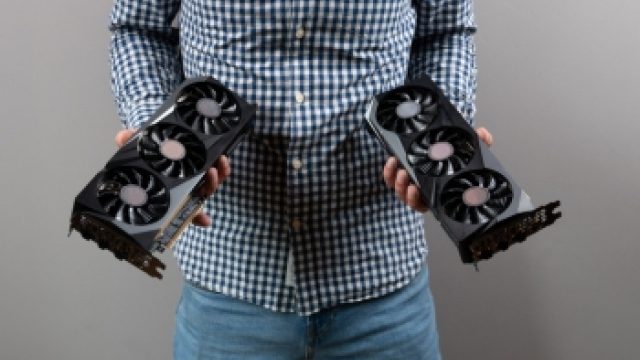What is a Graphics Card for Gaming? It’s like giving your computer a dose of steroids for video games!
Join the pixel-pumping party as we unveil the magic behind these graphical powerhouses, and level up your gaming experience like never before. Ready to game on, dear reader?
Let’s geek out together! Keep reading to discover the secret sauce behind graphics cards and why they’re the ultimate gaming sidekick!
What is a Graphics Card for Gaming?
A Graphics Card, also known as a GPU (Graphics Processing Unit), is a specialized component in a computer that handles rendering and displaying visual data, primarily aimed at enhancing gaming experiences.
Unlike the CPU (Central Processing Unit), which handles general computing tasks, the Graphics Card is designed specifically to process complex graphical calculations and render them into images that you see on your screen during gameplay.
Importance of Graphics Cards in Modern Gaming
As the gaming industry grows exponentially, so does the demand for visually stunning and realistic gaming experiences. This is where Graphics Cards shine, as they significantly impact the overall gaming performance and visual quality.
A powerful Graphics Card allows you to play games at higher resolutions, smoother frame rates, and with breathtaking visual effects, making you feel like you’re part of the game world.
Evolution of Graphics Cards
The journey of Graphics Cards began with simple 2D rendering capabilities in the early days of gaming. However, with the advent of 3D gaming, Graphics Cards needed to evolve rapidly to keep up with the demand for better visuals.
Over the years, we have witnessed several generations of Graphics Cards, each more powerful than the last, bringing groundbreaking advancements in technology and performance.
Components and Architecture of a Graphics Card
To understand how Graphics Cards work, let’s look at their components and architecture. At the heart of every Graphics Card, we have the GPU, which consists of thousands of cores that process data in parallel.
These cores work together to render complex graphics quickly. Additionally, Graphics Cards come with VRAM (Video Random Access Memory), which stores textures, frame buffers, and other data required for rendering.
Related Article: Do You Need a Graphics Card for a PC
How Graphics Cards Improve Gaming Performance
A Graphics Card’s primary objective is to deliver smooth and lag-free gaming experiences. But how does it do that? When you launch a game, the CPU sends the necessary game data to the GPU, which then processes the data and renders the frames.
A more powerful GPU with a higher core count and clock speed can process these frames faster, resulting in higher frame rates and smoother gameplay.
Gaming Resolutions and Graphics Cards
The resolution at which you play games directly correlates with the Graphics Card’s workload. Higher resolutions, such as 1440p and 4K, demand more graphical processing power.
To play games at these resolutions with high settings, you’ll need a high-end Graphics Card.
However, for 1080p gaming, which is still prevalent, a mid-range Graphics Card can deliver excellent performance.
Graphics Settings and Optimization
Graphics Cards allow players to fine-tune their gaming experience by adjusting graphics settings. These settings control the level of detail and visual effects in games. If you have a powerful Graphics Card, you can crank up these settings to enjoy stunning visuals.
On the other hand, if your GPU is struggling, lowering these settings can improve frame rates without compromising the overall experience.
Graphics Card Brands and Models
Various companies manufacture Graphics Cards, each offering a range of models with different performance levels and features.
Prominent players in the market include NVIDIA and AMD. NVIDIA’s GeForce series and AMD’s Radeon series are popular among gamers, and they continually compete to outdo each other with their latest releases.
Cooling and Maintenance for Graphics Cards
Graphics Cards can generate a significant amount of heat during intense gaming sessions. To prevent overheating and potential damage, Graphics Cards come equipped with cooling solutions, including fans and heatsinks.
Ensuring proper airflow in your PC case and keeping the Graphics Card clean from dust is crucial for maintaining its performance and longevity.
Related Article: 7 Best Graphics Card for Fallout 4 (Used by Experts!)
Upgrading Your Graphics Card
As games become more demanding, you might find that your current Graphics Card struggles to keep up.
Upgrading to a more powerful GPU can breathe new life into your gaming rig, allowing you to play the latest titles at higher settings. However, before upgrading, ensure that your PC’s power supply and other components can support the new Graphics Card.
Future Trends in Graphics Cards for Gaming
The future of Graphics Cards is filled with excitement and innovation. With advancements in technologies like ray tracing and AI-driven rendering, we can expect even more realistic visuals and immersive experiences.
Moreover, Graphics Cards are likely to become more power-efficient, enabling gamers to enjoy better performance without excessive energy consumption.
Role of Graphics Drivers
Graphics Drivers play a critical role in the performance and stability of Graphics Cards.
These software components act as a bridge between the operating system and the GPU, translating commands and optimizing performance.
Regularly updating your Graphics Drivers ensures that your Graphics Card operates at its best and takes advantage of the latest improvements and optimizations.
Graphics Cards and Virtual Reality (VR)
Virtual Reality has opened up new horizons in gaming, offering an unparalleled sense of presence and immersion.
To deliver smooth and realistic VR experiences, powerful Graphics Cards are a necessity. VR games demand a high frame rate and low latency to prevent motion sickness and provide a convincing virtual world.
Graphics Card and E-Sports
Competitive gaming, or E-Sports, requires not only skill but also a capable gaming setup.
A high-performance Graphics Card is essential for E-Sports enthusiasts, as it allows them to maintain high frame rates and low input lag, giving them a competitive edge over their opponents.
FAQs About What is a Graphics Card for Gaming
Do you need a graphics card for gaming?
Yes, a graphics card is essential for gaming as it handles the rendering of graphics and affects the overall visual quality and performance of games.
What graphics card do gamers use?
Gamers typically use high-performance graphics cards from popular brands like NVIDIA and AMD. These cards offer advanced features, powerful GPUs, and sufficient VRAM to handle demanding games.
What is the difference between a gaming card and a graphics card?
A gaming card and a graphics card are essentially the same thing.
The term “gaming card” is often used to refer to graphics cards specifically designed for gaming purposes, emphasizing their suitability for gaming-related tasks.
How much graphics card is good for gaming?
The ideal graphics card for gaming depends on various factors like the desired game settings, resolution, and the games you intend to play.
Generally, a mid-range graphics card with at least 4GB of VRAM is a good starting point for most gaming enthusiasts.
What is the cost of a graphics card?
The cost of a graphics card can vary significantly based on its brand, model, and performance level.
Entry-level graphics cards can start around $100, while high-end ones can exceed $1,000.
Is a 6GB graphics card enough for gaming?
A 6GB graphics card can be sufficient for gaming, especially at 1080p resolution.
However, for more demanding games or higher resolutions, a graphics card with a larger VRAM capacity may be beneficial to ensure optimal performance.
How much RAM is needed for gaming?
The amount of RAM required for gaming depends on the specific game and its system requirements.
In general, 8GB of RAM is considered the minimum for gaming, but 16GB or more is recommended for better performance, especially in modern games.
What graphics card is recommended for PUBG?
PUBG (PlayerUnknown’s Battlegrounds) is a relatively demanding game.
To play it smoothly, a mid-range or higher graphics card, such as NVIDIA GeForce GTX 1060 or AMD Radeon RX 580, is recommended.
Does PUBG utilize the GPU?
Yes, PUBG utilizes the GPU (Graphics Processing Unit) to render and process the game’s graphics, including textures, lighting, and special effects.
A capable GPU is crucial for achieving smooth and visually appealing gameplay.
How many GB is a graphics card?
A graphics card typically does not have a specific amount of memory in terms of gigabytes (GB). Instead, it contains VRAM (Video Random Access Memory), which ranges from 2GB to 24GB or more in high-end models.
The VRAM capacity affects the card’s ability to handle large amounts of textures and data.
What is the best graphics card size in terms of GB?
The best graphics card size in terms of VRAM (Video Random Access Memory) depends on your specific needs and budget.
For most gamers, a graphics card with 8GB to 12GB of VRAM provides a good balance of performance and value.
However, for enthusiasts or professionals engaging in tasks like 4K gaming or video editing, higher VRAM capacities may be desirable.
Final Thoughts About What is a Graphics Card for Gaming
In conclusion, a graphics card is a vital component for gaming, responsible for rendering and displaying graphics in games.
It plays a crucial role in determining the visual quality and overall performance of gaming experiences.
Gamers typically rely on high-performance graphics cards from reputable brands to meet their gaming needs.
The choice of a graphics card depends on factors such as game settings, resolution, and personal preferences.
While a mid-range graphics card with at least 4GB of VRAM can provide a decent gaming experience, more demanding games or higher resolutions may require cards with larger VRAM capacities.
Investing in a capable graphics card ensures smooth gameplay and immersive visuals for an enjoyable gaming journey.


